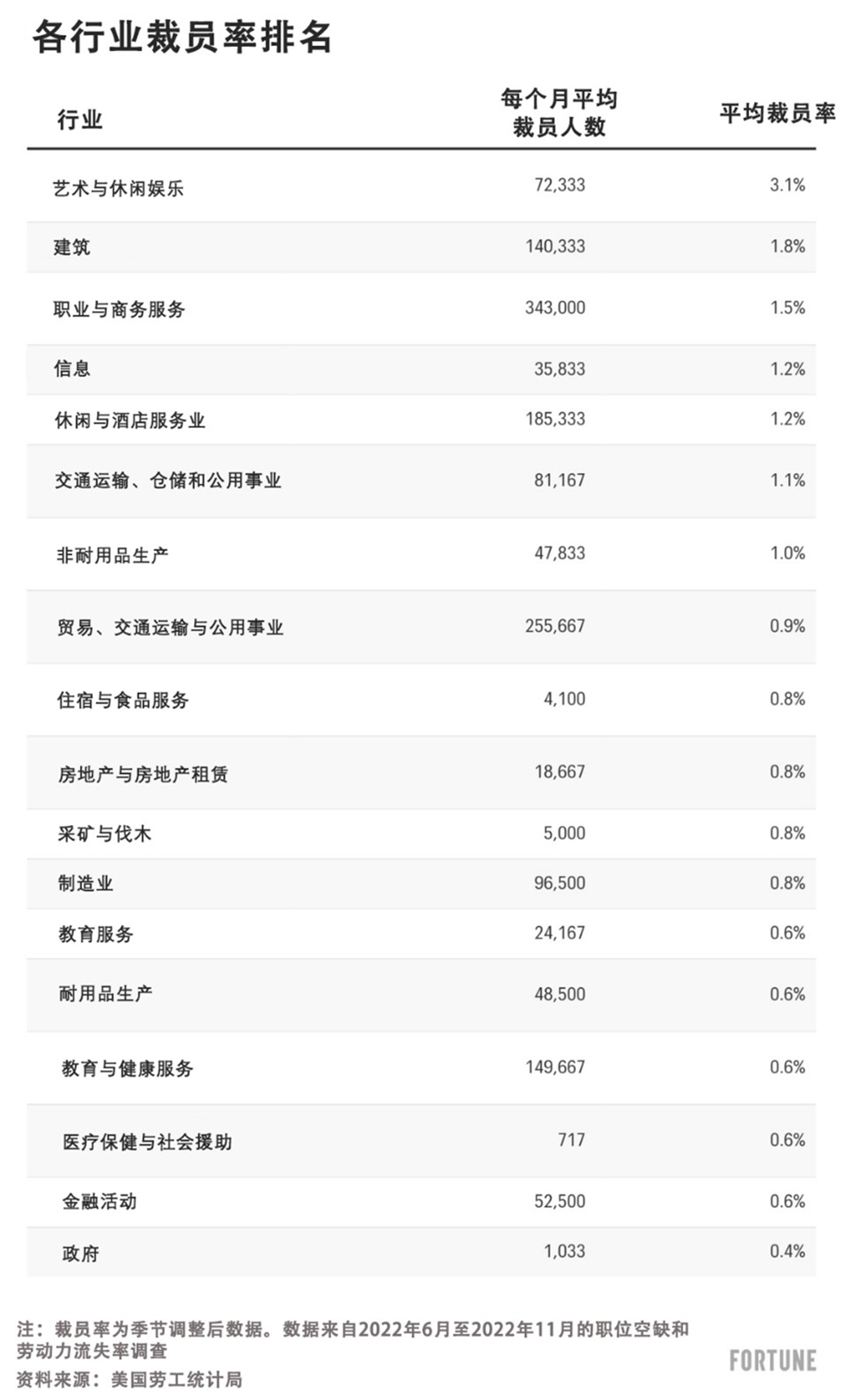
被裁员当然很糟糕。然而当前,在某些行业被裁员的几率可能大幅提高。经济下行,经济衰退正在迫近,但并非所有行业都会受到同样程度的影响。
最近,多家大型科技公司宣布裁员,并因此登上了媒体头条。但在过去六个月,大规模裁员的情况依旧相对较少。
有些行业确实经历了裁员,裁员率是其他行业的近三倍。美国劳工统计局(Bureau of Labor Statistics)的数据显示,尤其是艺术与休闲娱乐行业,从2022年6月至11月的平均裁员率为3.1%。这相当于每个月平均裁员人数约为72,000人。
裁员情况最严重的行业包括建筑、职业和商务服务(包括会计、工程和计算机服务等岗位)以及信息行业。信息行业涵盖了出版、传媒、电信和数据处理等领域。

科技业裁员备受关注,但这些岗位被分散到职业和商务服务以及信息行业。虽然按照美国劳工统计局的数据,这些行业的裁员率上升,但上升幅度并不严重。Indeed Hiring Lab的北美区经济研究总监尼克·邦克对《财富》杂志表示:“裁员率小幅上涨的部分原因,可能是一些非科技公司被包含在该行业当中,而这些公司在裁员方面的表现更好。”
许多科技公司通常还会提前几周通知,并且提供六个月的离职补偿金。这意味着与裁员有关的数据可能会出现滞后,等到这些被裁员工从公司的工资单中消失后才会有所体现。所以,虽然我们知道这些裁员,但他们可能尚未在数据中有所体现。
裁员人数依旧相对较低。邦克以建筑行业为例称:“虽然在统计期限内,许多行业的裁员率高于其他行业,但许多行业的裁员率实际上低于新冠疫情之前的水平。”过去六个月,建筑行业的平均裁员率为1.8%,是经济整体综合裁员率的两倍以上。但这低于2019年2.9%的平均裁员率。
Outsource Accelerator 的首席执行官及创始人德里克·加利莫尔表示,工作者在首次进入就业市场或考虑更换职业时,依旧应该考虑各行业的相关就业稳定性水平。
加利莫尔还说:“各行业的裁员率表面上乍一看差异较小,但我们发现,艺术与休闲娱乐业的从业者被裁员的可能性,比联邦政府雇员高13倍。”
在经济衰退或经济下行时期,哪些行业更稳定?领英(LinkedIn)发现,公用事业、教育、消费者服务甚至政府工作相对稳定。
数据证明了这一点。在2022年下半年,即使面临市场波动、高通胀和经济困境,政府雇员的裁员和解雇比率依旧最低。
邦克指出,医疗保健也是今年就业最稳定的行业。他说:“医疗保健是一个弹性行业,因为一方面对医疗服务的长期需求强劲,另一方面该领域已经面临人手不足的问题。”(财富中文网)
翻译:刘进龙
审校:汪皓
被裁员当然很糟糕。然而当前,在某些行业被裁员的几率可能大幅提高。经济下行,经济衰退正在迫近,但并非所有行业都会受到同样程度的影响。
最近,多家大型科技公司宣布裁员,并因此登上了媒体头条。但在过去六个月,大规模裁员的情况依旧相对较少。
有些行业确实经历了裁员,裁员率是其他行业的近三倍。美国劳工统计局(Bureau of Labor Statistics)的数据显示,尤其是艺术与休闲娱乐行业,从2022年6月至11月的平均裁员率为3.1%。这相当于每个月平均裁员人数约为72,000人。
裁员情况最严重的行业包括建筑、职业和商务服务(包括会计、工程和计算机服务等岗位)以及信息行业。信息行业涵盖了出版、传媒、电信和数据处理等领域。
科技业裁员备受关注,但这些岗位被分散到职业和商务服务以及信息行业。虽然按照美国劳工统计局的数据,这些行业的裁员率上升,但上升幅度并不严重。Indeed Hiring Lab的北美区经济研究总监尼克·邦克对《财富》杂志表示:“裁员率小幅上涨的部分原因,可能是一些非科技公司被包含在该行业当中,而这些公司在裁员方面的表现更好。”
许多科技公司通常还会提前几周通知,并且提供六个月的离职补偿金。这意味着与裁员有关的数据可能会出现滞后,等到这些被裁员工从公司的工资单中消失后才会有所体现。所以,虽然我们知道这些裁员,但他们可能尚未在数据中有所体现。
裁员人数依旧相对较低。邦克以建筑行业为例称:“虽然在统计期限内,许多行业的裁员率高于其他行业,但许多行业的裁员率实际上低于新冠疫情之前的水平。”过去六个月,建筑行业的平均裁员率为1.8%,是经济整体综合裁员率的两倍以上。但这低于2019年2.9%的平均裁员率。
Outsource Accelerator 的首席执行官及创始人德里克·加利莫尔表示,工作者在首次进入就业市场或考虑更换职业时,依旧应该考虑各行业的相关就业稳定性水平。
加利莫尔还说:“各行业的裁员率表面上乍一看差异较小,但我们发现,艺术与休闲娱乐业的从业者被裁员的可能性,比联邦政府雇员高13倍。”
在经济衰退或经济下行时期,哪些行业更稳定?领英(LinkedIn)发现,公用事业、教育、消费者服务甚至政府工作相对稳定。
数据证明了这一点。在2022年下半年,即使面临市场波动、高通胀和经济困境,政府雇员的裁员和解雇比率依旧最低。
邦克指出,医疗保健也是今年就业最稳定的行业。他说:“医疗保健是一个弹性行业,因为一方面对医疗服务的长期需求强劲,另一方面该领域已经面临人手不足的问题。”(财富中文网)
翻译:刘进龙
审校:汪皓
Getting laid off sucks. But the chances of it happening to you can increase depending on what industry you work in. And despite the looming threat of a recession, not all industries are impacted to the same degree during an economic downturn.
While the tech industry has made headlines with layoffs announced at several major companies recently, widespread layoffs still have remained relatively scarce over the last six months.
But other industries did experience layoffs—nearly triple the rate compared to others. The arts, entertainment, and recreation sector, in particular, had an average layoff rate of 3.1% from June to November 2022, according to data from the Bureau of Labor Statistics. This adds up to an average of about 72,000 employees laid off per month.
The other top sectors for layoffs included construction, professional and business service—which includes jobs in accounting, engineering and computer services—and the information industry. That sector covers those working in publishing, media, and telecommunications, as well as data processing.
Tech layoffs have been very high-profile, but the jobs are spread across the professional and business services as well as information sectors. And while those industries have seen a rise in layoff rates recorded by the BLS, the spike hasn’t yet been severe. “Part of this shallow rise might be because other non-tech companies are included in this sector and are doing better on the layoff front,” Nick Bunker, economic research director for North America at the Indeed Hiring Lab, tells Fortune.
Many tech companies also typically provide several weeks of lead time and severance packages up to six months. That means the data around discharges may be delayed until after those employees exit the payroll. So while we know about the layoffs, they may not yet be appearing in the data.
Still, the number of layoffs is relatively low. “While the layoff rates in many of these industries are high compared to other industries during that time period, many of these rates are actually low compared to pre-pandemic years,” Bunker says, citing the construction industry as an example. Over the past six months, the average layoff rate in the construction sector was 1.8%, which is more than double the aggregate rate for the whole economy. But that's less than the 2.9% average layoff rate in 2019: 2.9%.
Yet workers should still consider the level of job stability associated with each industry when entering the job market for the first time or considering a change of career, says Derek Gallimore, CEO and founder of Outsource Accelerator.
“While the difference between the percentages may at first appear small, we found that those in the arts, entertainment, and recreation industry are actually 13 times more likely to be laid off than those working for the federal government,” Gallimore adds.
So what industries tend to be more stable, even in a recession or economic downturn? LinkedIn has found that sectors like utilities, education, consumer services, and even government jobs tend to be fairly stable.
The data bears that out. Even with the market volatility, high inflation, and economic hardships during the second half of 2022, government employees saw the lowest rate of layoffs and discharges.
Health care may also be a more stable sector as well this year, Bunker says. “Health care has been a resilient sector due in part to the strong long-term demand for health services and already tight staffing in the field,” he says.






